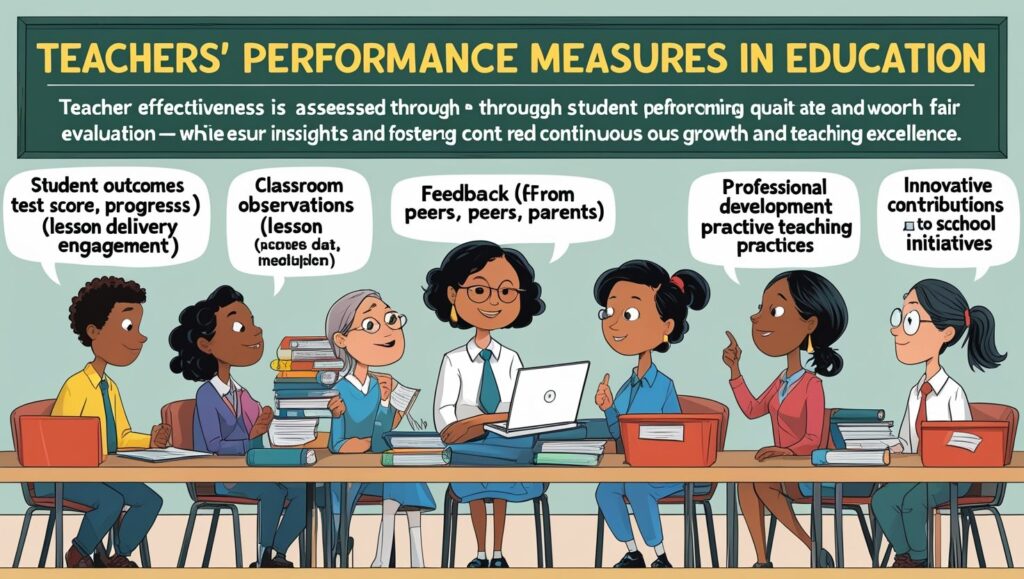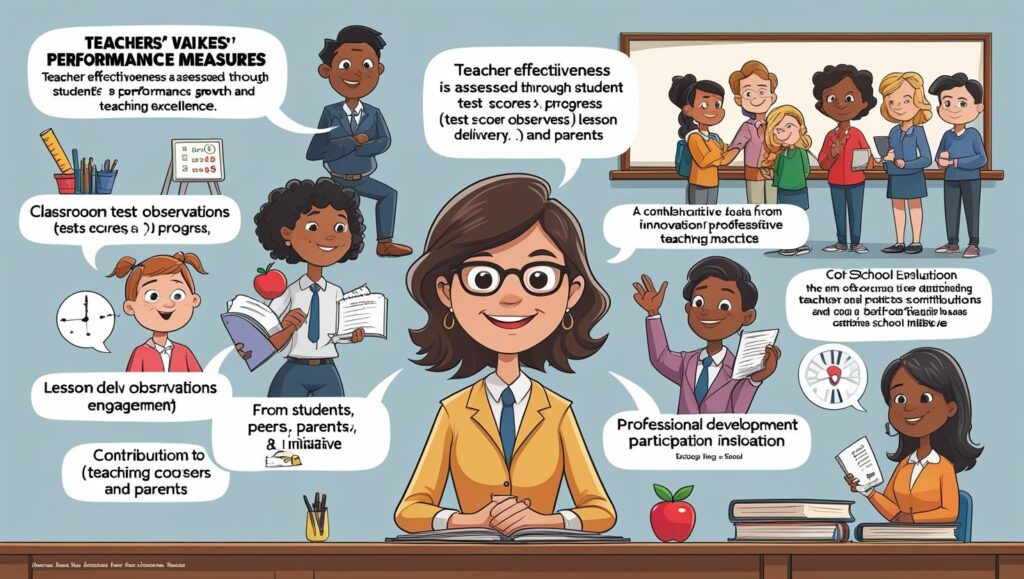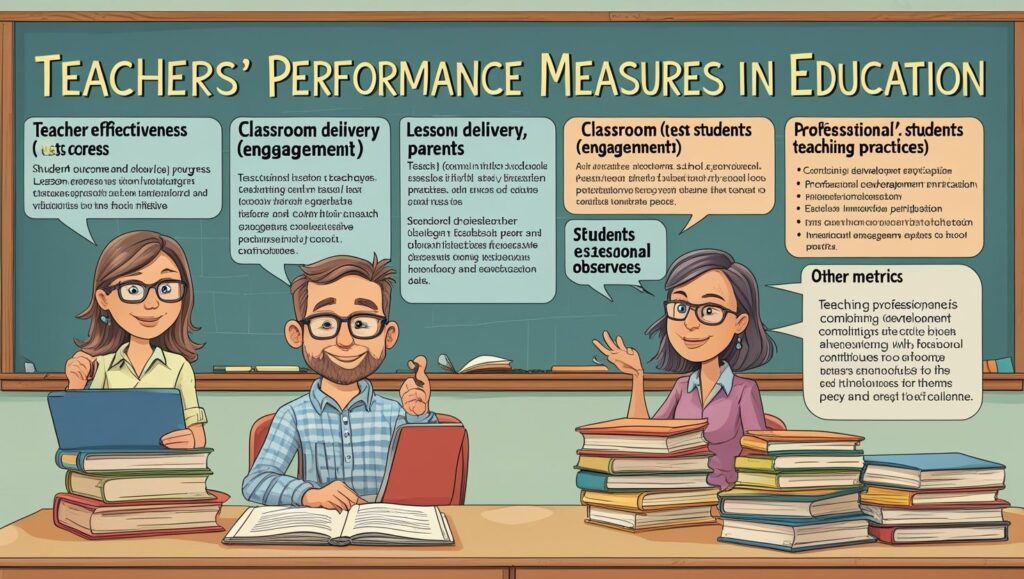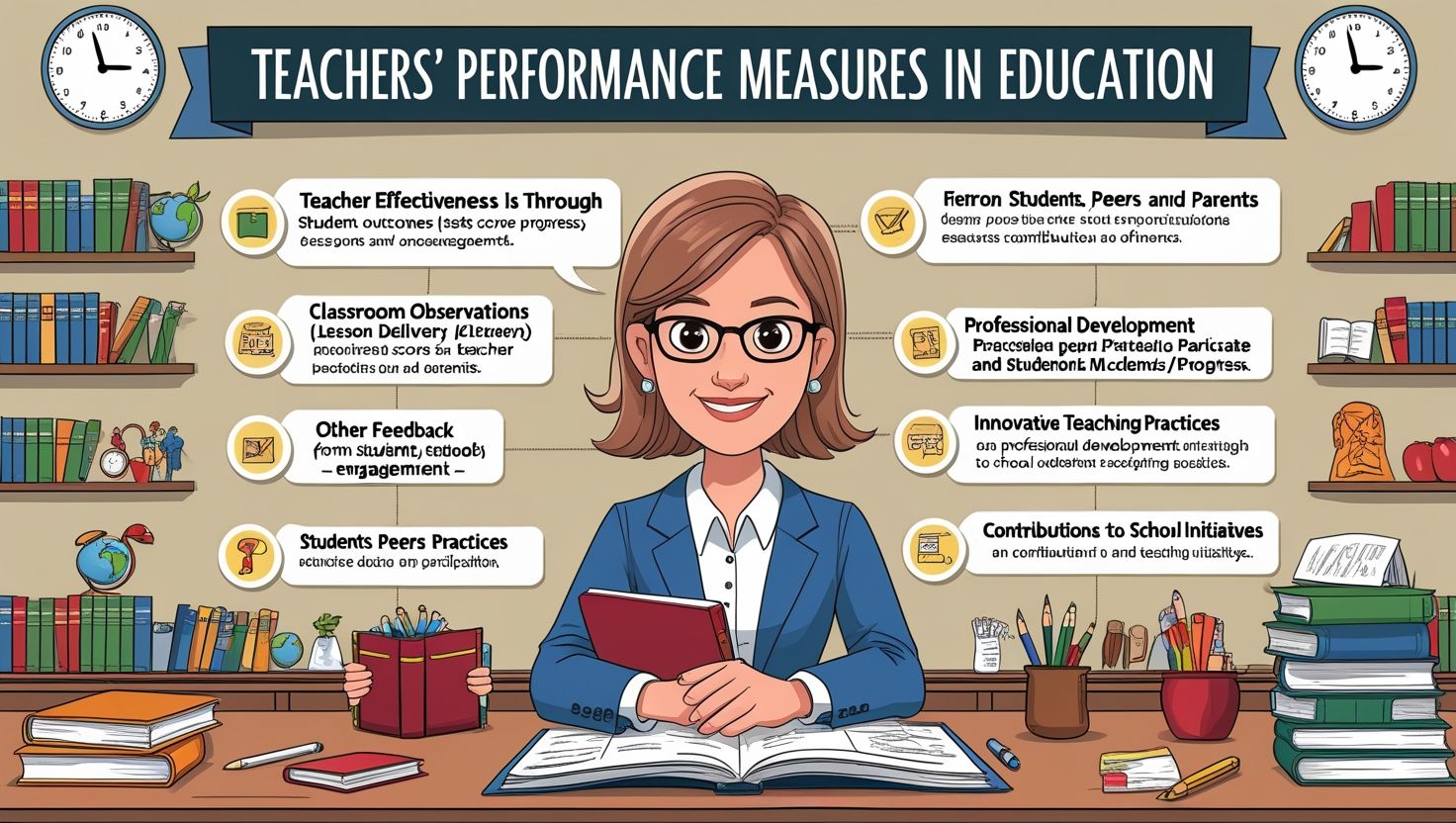Introduction
Teachers’ Performance Measures in Education, Teachers play a central role in shaping education. Their performance directly affects student learning. Without effective teachers, quality education cannot be ensured. Therefore, measuring teacher performance is crucial. It helps in understanding strengths and areas needing improvement. Moreover, performance measures ensure accountability. Schools rely on teacher evaluations to maintain standards. With growing emphasis on learning outcomes, teacher performance has gained attention. Also, stakeholders—parents, students, and administrators—expect transparency.
In addition, good performance improves teacher motivation. When teachers know they are evaluated fairly, they strive to do better. However, measuring performance can be complex. It involves both quantitative and qualitative aspects. This includes classroom results, student feedback, and professional development. Consequently, education systems must apply multiple methods. A single method cannot reflect complete performance. Furthermore, teaching involves various factors. These range from lesson planning to classroom management. Hence, comprehensive evaluation tools are necessary.
Eventually, fair assessments lead to improvement. They help in recognizing excellence and guiding low performers. All in all, teacher performance measurement supports growth. It boosts teaching quality. Therefore, it benefits students and the entire education system.
Classroom Observation as a Key Measure
Classroom observation is a common way to measure performance. It allows supervisors to see teaching in real time. Observers look at how teachers manage the class. They check how teachers explain concepts and engage students. Importantly, this method provides direct evidence. Unlike test results, it shows real interaction. It reveals teaching style, clarity, and communication. Also, observers can assess classroom environment. Is it safe and positive? Do students feel respected?
In many cases, observations are formal. Evaluators use rubrics or checklists. They may rate performance on various standards. These include lesson delivery, student engagement, and use of materials. Observers also provide feedback afterward. This supports improvement. However, informal observations are also useful. Peer observations, for example, offer support. They encourage collaboration. Teachers can learn from one another. Moreover, multiple observations give a fuller picture. One session alone may not be enough.
Still, this method must be fair. Bias can affect results. Therefore, training observers is important. Consistent criteria should guide evaluations. When done right, observations are powerful. They promote reflection and help teachers grow. Thus, classroom observation remains an essential performance tool. It gives direct insight into teaching quality.

Student Achievement and Test Results
Student performance is often used to evaluate teachers. When students perform well, it reflects effective teaching. However, this link must be analyzed carefully. Many factors affect student results. Still, consistent progress can signal strong instruction. Standardized tests provide data for analysis. They help measure academic gains over time. Teachers whose students show improvement are considered effective. Additionally, comparisons across classes or schools are made. These highlight differences in teaching approaches.
Importantly, growth models are preferred over raw scores. They track student improvement from one year to the next. This gives a fairer measure. A student starting low but showing growth still reflects good teaching. However, test data alone is not enough. It should be combined with other measures. Relying only on scores may overlook broader skills. Not all learning is captured in exams. Creativity, collaboration, and motivation also matter.
Also, some subjects lack standardized tests. In such cases, alternative assessments are needed. These include portfolios and projects. Overall, student outcomes are valuable indicators. But they must be interpreted within context. Therefore, balanced use of achievement data supports teacher evaluation. It adds objectivity, yet needs careful analysis. When paired with other tools, it helps paint a complete picture.
Student Feedback and Surveys
Student feedback provides a unique perspective. Students interact with teachers daily. They notice things others might miss. Thus, their input helps assess teaching effectiveness. Surveys are a common tool for collecting this feedback. Usually, surveys ask about clarity, fairness, and support. Do students feel understood? Are their questions answered? Are they encouraged to participate? Responses to these questions reveal valuable information.
Moreover, student surveys show engagement levels. Motivated students often reflect good teaching. If many feel bored or confused, there may be issues. This feedback helps identify areas needing improvement. Additionally, surveys promote student voice. They make learners feel valued. When students contribute to school improvement, they gain responsibility. It builds a healthy learning culture.
Still, surveys must be age-appropriate. Younger children may need simpler formats. Also, responses should be anonymous. This ensures honest answers. Furthermore, results should be used constructively—not for punishment. Teachers can reflect on this feedback. They can adjust methods and strategies. Also, positive responses boost morale. Teachers see the impact of their work.
All in all, student feedback is a vital part of performance evaluation. It adds a learner-centered view. It balances administrative perspectives. Thus, it strengthens the assessment system.

Peer Reviews and Teacher Collaboration
Peer review involves teachers assessing one another. This promotes professional learning. It builds trust and collaboration. Unlike top-down evaluations, it encourages mutual growth. In a peer review, teachers observe classes. They share constructive feedback. Also, they discuss teaching strategies. This process improves both parties. Observers learn new ideas too.
Moreover, peer review fosters teamwork. Teachers feel supported, not judged. They are more open to change. It also promotes consistency. Good practices spread across staff. However, training is necessary. Teachers must know how to give feedback. Reviews should follow clear criteria. Confidentiality must be respected. This builds credibility.
In many schools, peer mentoring is part of development plans. New teachers benefit greatly. They get guidance from experienced colleagues. Also, veterans gain fresh insights from younger staff. Furthermore, collaborative planning helps. When teachers work together on lessons, quality improves. Sharing materials and experiences enriches learning.
Despite some challenges, peer review adds depth to evaluations. It supports continuous improvement. Teachers are more likely to accept feedback from equals. It complements formal assessments. Thus, peer reviews are an effective performance measure. They promote learning, build unity, and enhance teaching standards.
Professional Development Participation
Participation in professional development is a performance indicator. Teachers must keep learning to stay effective. Education keeps changing. New methods, tools, and content emerge regularly. Therefore, attending workshops and training is important. It shows commitment to growth. Also, it ensures teachers update their skills. Schools often track attendance and involvement in such programs.
Moreover, professional development improves classroom practice. Teachers learn new strategies. They gain confidence and creativity. In turn, this enhances student learning. Additionally, these programs cover diverse areas. Some focus on subject content. Others deal with classroom management, technology use, or inclusion. Each adds value to teaching.
Furthermore, teachers who share learned knowledge contribute more. They lead workshops or guide peers. This spreads improvement across the school. However, the quality of training matters. It should be relevant and practical. Teachers must be able to apply it in class. Feedback on training helps improve future programs.
Eventually, regular professional growth leads to better performance. It keeps teachers motivated and informed. Hence, tracking development activities helps in evaluations. Altogether, this measure reflects dedication. It ensures teachers evolve with time. So, it is essential for performance assessments.
Lesson Planning and Curriculum Implementation
Effective lesson planning is vital for good teaching. It shows preparation and clarity. Teachers who plan well ensure smooth delivery. Thus, it’s an important performance measure. Plans outline learning goals, methods, and assessments. They guide the teaching process. Evaluators often review these plans. They check alignment with the curriculum. They also look at differentiation for diverse learners.
Moreover, planning reflects teacher understanding. It shows knowledge of content and pedagogy. A clear plan supports student learning. It ensures that objectives are met. Besides planning, how the curriculum is implemented matters. Teachers must follow guidelines. But they also adapt to class needs. Therefore, flexibility is key.
Furthermore, resources used in lessons matter. Are they suitable? Are they engaging? These questions influence learning outcomes. Technology integration is also assessed. Documentation of plans provides evidence. It helps in accountability. Also, sharing plans with peers promotes teamwork.
In conclusion, lesson planning and curriculum use are performance indicators. They show preparation, structure, and professionalism. Regular review of plans supports growth. Hence, administrators should include this measure. It ensures instruction remains effective and goal-driven.
Use of Technology in Teaching
Technology is changing education. Teachers must adapt to digital tools. Effective use of technology reflects modern teaching. It also improves student engagement. Therefore, tech use is a performance measure. Teachers who use smart boards, online resources, or learning platforms show innovation. They keep lessons interactive. They reach digital-age learners better.
Moreover, during online classes, tech use became vital. Teachers had to manage platforms, content, and student interaction. Those who succeeded proved their skills. Evaluators can observe how tools are used. Is the technology supporting learning? Is it used efficiently? Or is it just for show? These questions help measure quality.
In addition, teachers who integrate technology in assessments stand out. Online quizzes, interactive polls, or educational games add variety. Also, managing classroom tech matters. Keeping students focused and safe online is important. Teachers must know digital ethics and security.
Furthermore, professional development in tech should be encouraged. Teachers who stay updated with digital trends perform better. Thus, tech use reflects adaptability and growth. It helps teachers connect better with students. So, it’s a key part of performance evaluation in modern schools.

Communication with Parents and Stakeholders
Communication is a major part of teaching. Teachers must engage with parents and stakeholders. This ensures a supportive learning environment. Hence, communication skills are part of performance measures. Teachers regularly update parents on student progress. They share test results, behavior updates, and class news. Clear, respectful, and timely messages build trust.
Also, parent-teacher meetings are evaluated. Are they productive? Are concerns addressed? Is support offered? These interactions reflect professionalism. Moreover, teachers must listen. Active listening shows care. Responding to concerns politely strengthens relationships. Also, collaboration with community groups is important.
Technology helps here too. Emails, school apps, and calls aid communication. Teachers who use these tools effectively keep everyone informed. In addition, teachers must respect diversity. They must understand cultural differences. This supports inclusive dialogue.
Feedback from parents is useful. It reveals satisfaction levels. It helps assess a teacher’s communication. Eventually, open communication improves outcomes. Students perform better when parents are involved. So, this is a valid performance measure. Therefore, schools must include communication in evaluations. It shows relationship management and care for learners.
Conclusion and Recommendations
Measuring teacher performance is essential. It ensures quality education. It supports teacher growth. Also, it helps identify training needs. Therefore, schools must apply varied methods. Classroom observations give direct insight. Student results reflect outcomes. Feedback from students and peers adds depth. Lesson planning shows preparation. Communication shows engagement.
Moreover, participation in training and use of technology show adaptability. Each measure has strengths. Combined, they provide a fair picture. However, fairness is key. Evaluations must be transparent. Bias must be avoided. Teachers should receive feedback with support. Also, performance should not be used to punish. It should guide improvement. Schools must create a positive culture. Teachers should feel valued, not threatened.
Recommendations include:
- Use multiple tools.
- Train evaluators.
- Collect regular feedback.
- Involve teachers in the process.
- Link performance to professional growth.
In conclusion, performance measures ensure accountability. They uphold teaching standards. Most importantly, they help students succeed. So, measuring teacher performance is not just necessary—it’s vital for educational success.

It’s great to see someone explain this so clearly.
This article came at the perfect time for me.
I’m definitely going to apply what I’ve learned here.
I wasn’t sure what to expect at first, but this turned out to be surprisingly useful. Thanks for taking the time to put this together.
I like how you presented both sides of the argument fairly.
What I really liked is how easy this was to follow. Even for someone who’s not super tech-savvy, it made perfect sense.
Thank you for being so generous with your knowledge.
I enjoyed every paragraph. Thank you for this.
This was a great reminder for me. Thanks for posting.
This was so insightful. I took notes while reading!
Your advice is exactly what I needed right now.
What I really liked is how easy this was to follow. Even for someone who’s not super tech-savvy, it made perfect sense.
What I really liked is how easy this was to follow. Even for someone who’s not super tech-savvy, it made perfect sense.
Posts like this are why I keep coming back. It’s rare to find content that’s simple, practical, and not full of fluff.
I appreciate the depth and clarity of this post.
Thank you for offering such practical guidance.
This topic really needed to be talked about. Thank you.
I enjoyed your take on this subject. Keep writing!
This helped clarify a lot of questions I had.
This content is really helpful, especially for beginners like me.
Such a thoughtful and well-researched piece. Thank you.
This content is gold. Thank you so much!
I’ll definitely come back and read more of your content.
This was so insightful. I took notes while reading!
I never thought about it that way before. Great insight!
This post cleared up so many questions for me.
I love the clarity in your writing.
It’s refreshing to find something that feels honest and genuinely useful. Thanks for sharing your knowledge in such a clear way.
You write with so much clarity and confidence. Impressive!
I really needed this today. Thank you for writing it.
Thank you for being so generous with your knowledge.
xojkvi
fw310b
I savor, lead to I found just what I used to be having a look for. You have ended my four day long hunt! God Bless you man. Have a nice day. Bye
I’ve been browsing on-line more than thtee hours nowadays, but I by no
means founnd any fascinatfing article like yours. It’s beautiful price enough for me.
In my view, iif all web owners and bloggers made good content as you probably did,
the net will probably be a lot more helpful than ever before. https://glassi-info.blogspot.com/2025/08/deposits-and-withdrawals-methods-in.html
obviously like your web site but you need to check the spelling on quite a few of your posts. Several of them are rife with spelling issues and I find it very troublesome to tell the truth nevertheless I will surely come back again.
top 10 casino in canada, online gambling uk statistics and canada best slot machine, or
australian online casino no deposit signup bonus
Feel free to surf to my site … New betting sites free spins (https://goplayslots.net)
top online pokies and casinos united statesn rockets, no deposit
bonus codes usa and free spins 2021 and usa how much money do casinos hold (Andrea) free spins,
or las vegas usa casino $100
statistics of gambling in canada, usa pokies online and no deposit online bingo usa allowed, or big poker tournaments harrah’s casino in the bahamas,
Woodrow, australia
sportwetten bonus ohne oasis
Here is my site :: basketball Wm wetten
gratis bonus ohne einzahlung sportwetten
Also visit my web site :: tipp wetten Vorhersage (https://anhangafilmes.com.br)
hunderennen aussenseiter wetten strategie (Tiara) deutschland
wetten österreich türkei
Stop by my web blog … buchmacher üBersicht (http://www.afrilaw.co.za)
wettanbieter
Here is my homepage – sportwetten bonus neu
wettrechner kombiwette
My blog … Pferderennen Wetten Quoten
top wettanbieter
Feel free to visit my site :: was ist eine kombiwette (Hulda)
sportwetten bonus neu
my webpage … ihre wette in sicheren händen (Tabatha)
wettquoten papst
Have a look at my site :: Vermittler von wetten bei pferderennen
handicap wette
Stop by my web page – Online Sport-Wetten
live sport wetten
Feel free to visit my homepage sportwetten anbieter Schweiz
sportwetten tipps kaufen legal interwetten
kostenlos Online Wetten Mit Startguthaben Ohne Einzahlung ohne einzahlung
wett tipps-heute
My web page :: Sportwetten Online legal – Createundangan.com –
Hey, I think your blog might be having browser compatibility issues. When I look at your blog in Ie, it looks fine but when opening in Internet Explorer, it has some overlapping. I just wanted to give you a quick heads up! Other then that, terrific blog!
pferderennen wett tipps
My web page :: bester wettanbieter mit bonus; https://Ergenskoparty.com/,
I’ll right away seize your rss as I can’t in finding your email subscription hyperlink or e-newsletter service. Do you’ve any? Kindly let me realize in order that I may subscribe. Thanks.
Nicely crafted